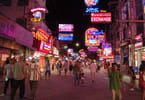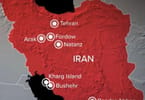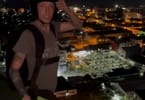I had never been to the Savute region of Botswana before, but I had read that it was the place to see during the rainy season. The books said that the Savute Channel had dried up completely in 1982, that during the dry season it was a dustbowl. The books also mentioned that when the rains fell, the Channel became a series of waterholes and lush grassland where the plains game flocked, followed by all the predators.
So when we arrived at Savute, I was quite surprised to see a river. I was told that the Savute Channel had filled up in 2009 and had remained full during the dry season. Now, after the local rain in 2010, the water in the Channel was still high.
The Kwando River, which flows on the border between Botswana and Namibia, takes a sharp bend to become the Linyanti River. Eons ago, the Kwando used to flow south into the Okavango region, flowing on into the Makgadikgadi pans, formerly the site of a vast inland sea. Movements in the Earth’s crust stopped the flow southwards and sent it north to meet the Linyanti and Chobe and onward into the Zambezi River.
There is still a connection between the Kwando/Linyanti and the Okavango known as the Selinda Spillway. The Spillway has also been dry for many years but is now flooded – water flowing from the Okavango to the Linyanti. The difference in elevation is extremely slight (no more than ten meters over fifty kilometers) and the spillway has, I was told, been known to flow in either direction.
Much has altered this landscape in the past, and it is difficult to explain in but a few sentences. The fact that changes are still occurring as the Earth continues to rumble underneath and thus alter the course of rivers, makes the area even more fascinating.
Wilderness Safaris has the Linyanti Concession. In the past, they pumped waterholes along the Savute Channel to attract animals, but now that the channel is flooded, their pumps are no longer required. Instead they had to build a new bridge across it.
We traveled extensively around the area with our guide, Mr. T, and found a lot of game. We came across a pair of young male lions sitting in the shade of a bush waiting for their mother. We later found mum. She was about a kilometer away and was calling to her youngsters. She lay down and waited for them to arrive.
We saw a lot more animals and birds in our further travels around the area. The oxpeckers seemed to be working overtime picking ticks off many of the animals. In the photo, the giraffe is having a clean-up of his horns, and the kudu were not shy, posing nicely for photographs. A Burchell’s Starling was being harassed by its hungry cuckoo offspring; an open-billed stork was sunning himself, looking extremely comical. We saw lots more, but that will wait until the next story.
WHAT TO TAKE AWAY FROM THIS ARTICLE:
- Movements in the Earth's crust stopped the flow southwards and sent it north to meet the Linyanti and Chobe and onward into the Zambezi River.
- I had never been to the Savute region of Botswana before, but I had read that it was the place to see during the rainy season.
- The books also mentioned that when the rains fell, the Channel became a series of waterholes and lush grassland where the plains game flocked, followed by all the predators.






















